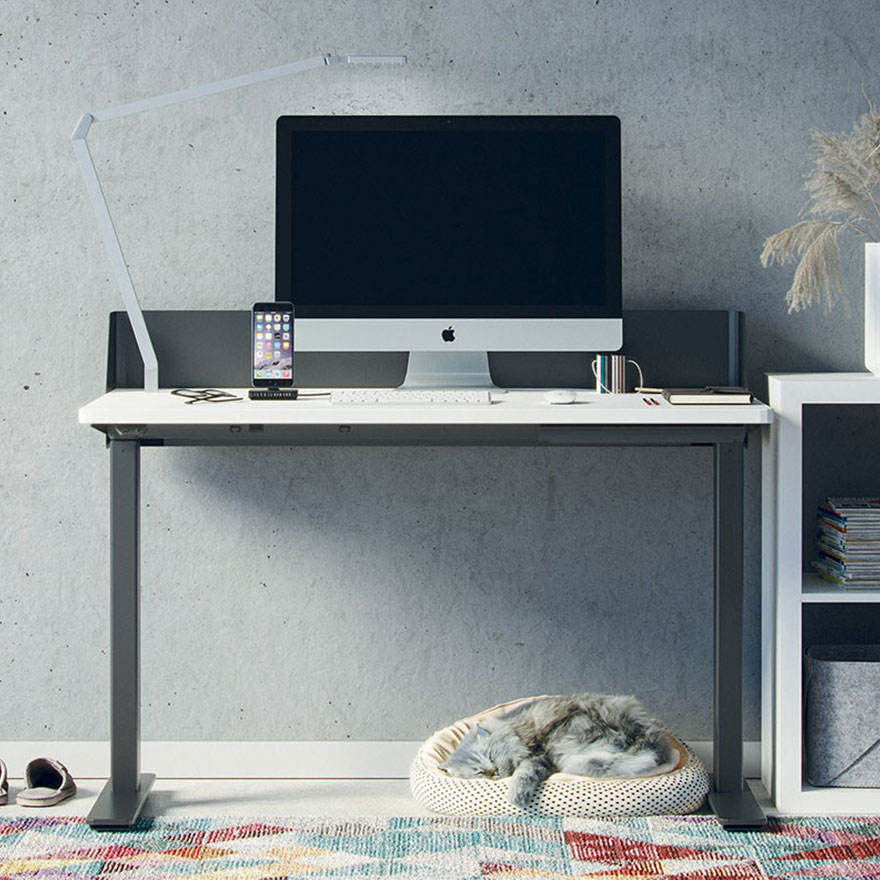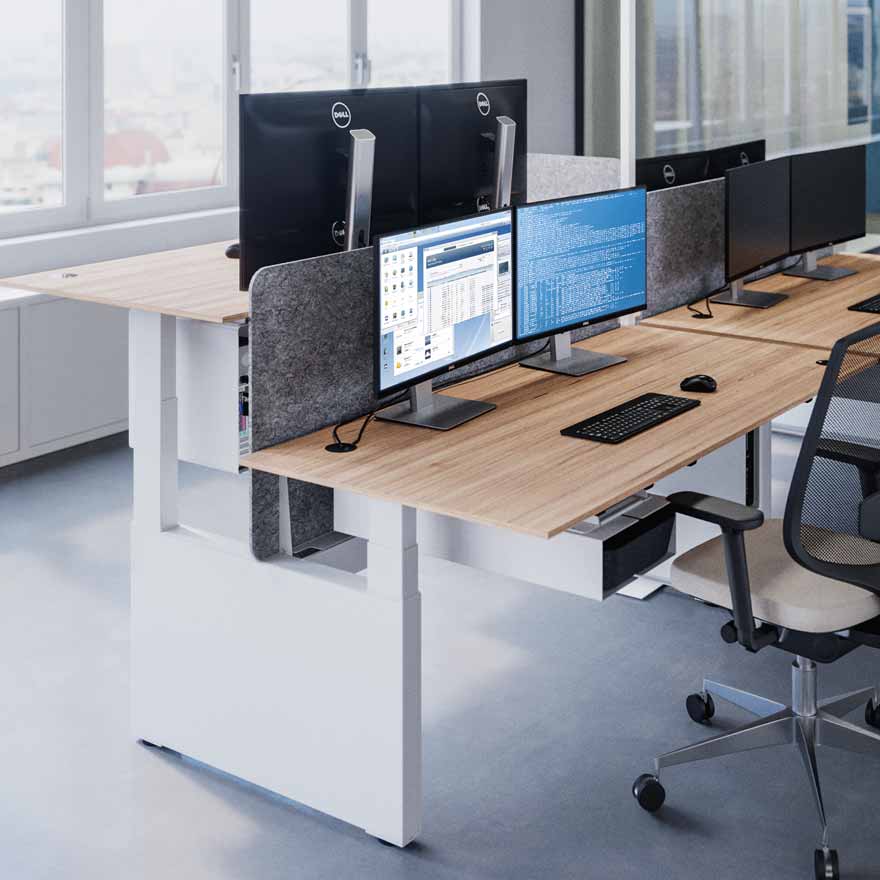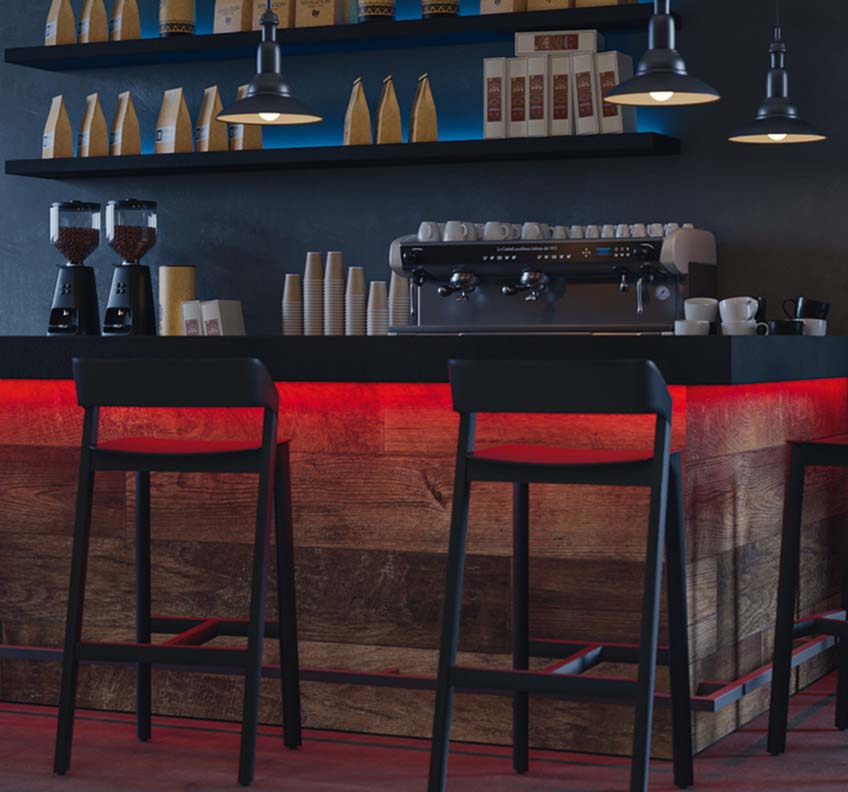Office Design Trends 2024
The traditional office landscape has undergone a profound transformation in the last few years, driven by the rise of hybrid work. This new model, where employees split their time between working in the office and remotely, is reshaping the way we design workspaces.

The Rise of Hybrid Workspaces
To accommodate the ebb and flow of in-person and remote workers, designers are getting creative with space utilisation. Gone are the days of rows of cubicles and assigned desks. The hybrid era calls for adaptable, flexible, and tech-enabled environments that cater to diverse work styles and needs. Hot desking allows employees to reserve a workspace for a specific period, ideal for those who come into the office occasionally or need a dedicated space for focused work when they do.
Modular furniture provides unmatched flexibility, think movable partitions, screens, and reconfigurable workstations that can be easily adapted to create team rooms, meeting areas, or quiet zones on demand. Collaboration zones are crucial for fostering in-person interaction and brainstorming sessions. These spaces can be equipped with whiteboards, writable walls, comfortable seating arrangements, and the latest presentation technology. Finally, quiet zones provide a sense of privacy and refuge for employees who need to focus on individual tasks or take video calls without distractions. These areas can be soundproofed and equipped with comfortable ergonomic chairs and task lighting.

Bringing the Outdoors In
Biophilic design, the integration of nature into the built environment, is gaining popularity as a powerful tool for enhancing well-being and productivity. Research shows that exposure to natural elements can reduce stress, improve cognitive function, boost creativity, and even strengthen the immune system. Here are some ways biophilic design can be incorporated into office spaces:
- Ample natural light: Skylights, light shelves, and large windows can maximise access to daylight, reducing reliance on artificial lighting and creating a more natural circadian rhythm for employees.
- Living walls and plants: Strategically placed greenery can purify the air, reduce noise levels, and add a touch of life to the workspace. Studies have shown that views of nature, even from indoor plants, can improve mood and cognitive function.
- Natural materials: Utilising wood, stone, water features, and other organic elements can create a calming and restorative atmosphere. Natural materials can also introduce texture and warmth to a space, making it more inviting and comfortable.

The Smart Office
Technology is seamlessly woven into the fabric of modern office design, creating a more intelligent and responsive work environment. Here are some areas to consider in your designs:
- Occupancy sensors: These detect when a space is occupied and automatically adjust lighting and temperature settings. This not only reduces energy consumption but also ensures a comfortable environment for employees.
- Smart lighting: Lighting systems can be programmed to adjust brightness and colour temperature throughout the day. Cooler, brighter light can be used in the morning to boost alertness, while warmer tones can be used in the afternoon to promote relaxation and focus.
- Integrated AV systems: Rooms can be equipped with high-definition displays, video conferencing technology, and intuitive controls for effortless presentations and collaboration, regardless of whether participants are physically present or joining remotely.
- Room booking systems: Employees can easily reserve conference rooms, huddle spaces, and quiet areas through user-friendly apps or digital displays. This eliminates the hassle of scheduling conflicts and ensures everyone has access to the space they need to be productive.
- Digital signage: Digital displays can be used for a variety of purposes, such as displaying wayfinding information, company announcements, real-time data visualisations, and even inspirational content to create a more engaging and dynamic work environment.

Making Wellbeing a Priority
The rise of hybrid working, where employees split their time between the office and remote locations, has brought employee well-being into the spotlight. Companies are recognising that a healthy, comfortable, and engaged workforce is crucial for productivity, creativity, and overall success. As a result, office design is evolving to prioritise employee well-being in several key ways:
Active Workspaces
Sedentary work environments can have detrimental effects on physical and mental health. Active workspaces encourage movement throughout the day, boosting circulation, energy levels, and focus. This means more companies are considering things like standing desks , treadmill or bike desks, balance boards and wobble stools. All of which are designed to keep the body moving and the mind focused.
Wellness Rooms
Mental well-being is just as important as physical health. Wellness rooms offer a sanctuary within the office, providing employees with a space to recharge, de-stress, and focus on their mental and emotional health. Think of quiet and calming atmospheres, muted colours, soft lighting, and comfortable seating areas. Some offices are also providing meditation or yoga areas, relaxation zones and biophilic design.

Designing a Sustainable Future
The growing awareness of environmental issues has led to a surge in interest in sustainability across all sectors, including the workplace. Sustainable office design is no longer just a trend; it's a necessity for businesses and individuals who want to minimise their environmental impact and contribute to a healthier planet. By designing eco-friendly spaces, you can reduce your clients’ carbon footprint, conserve resources, and create a more positive work environment for their employees. Some key sustainable office design practices to consider:
Energy-Efficient Lighting Systems: Buildings are major consumers of energy, and lighting, along with heating, ventilation, and air conditioning (HVAC) systems are significant contributors. By opting for energy-efficient systems, businesses can significantly reduce their energy consumption. LED lightinG is far more energy-efficient than traditional incandescent or fluorescent bulbs, lasts longer and produces less heat. Combined with smart lighting controls like occupancy sensors, daylight harvesting systems, and dimmable lights that automatically adjust lighting levels based on occupancy and natural light availability, minimise waste.
Eco-Friendly Materials: The construction and furnishing of office spaces have a significant environmental impact due to the extraction, production, and transportation of materials. Choosing eco-friendly alternatives minimises this impact and promotes a healthier indoor environment.
Water Conservation: Water scarcity is a growing global concern, and businesses have a responsibility to conserve this precious resource. Efficient water management in the office can lead to significant cost savings and environmental benefits.
The Benefits of Sustainable Office Design:
- Reduced Operating Costs: Energy and water efficiency lead to lower utility bills and long-term cost savings.
- Improved Employee Health and Productivity: A healthier indoor environment with better air quality and natural light boosts employee morale, well-being, and productivity.
- Enhanced Brand Reputation: Demonstrating a commitment to sustainability attracts environmentally conscious clients and employees.
Sustainable office design is a multi-faceted approach that encompasses energy efficiency, eco-friendly materials, water conservation, and more. By embracing these practices, businesses not only contribute to a healthier planet but also create a more positive, productive, and sustainable workplace for their employees.

Home Office Trends
The widespread adoption of remote work has transformed the way we perceive and utilise our homes. Home offices, once considered temporary or makeshift setups, are now essential spaces for many people. As remote work becomes a permanent fixture for a growing number of individuals and companies, there's a renewed focus on creating home offices that are not only functional and productive but also comfortable, personalised, and conducive to a good work-life balance.
Dedicated Workspaces
Creating a dedicated workspace, separate from the rest of the home, is crucial for establishing boundaries between work and personal life. It helps minimise distractions, improve focus, and signal to your brain that it's time to work. Ideally, this means a quiet room with a door that can be closed for privacy and noise reduction. However, if a separate room isn't available, designing a specific area within a room that makes use of room dividers or furniture to create a visual separation can be a creative alternative.
The Future of Home Offices
As remote work continues to evolve; we can expect to see even more innovative and personalised home office designs. Smart home technology, virtual reality tools, and biophilic design principles (incorporating natural elements) are just a few of the trends that could shape the future of home offices. The goal is to create spaces that not only support productivity but also enhance well-being and foster a healthy work-life balance. The hybrid era is an exciting time for office design. By embracing these trends, we can create workspaces that are not only functional and efficient but also inspiring, healthy, and sustainable. As designers and installers, we have the opportunity to shape the future of work and create environments where people thrive.










